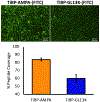Mitigation of peri-implantitis by rational design of bifunctional peptides with antimicrobial properties
- PMID: 32467858
- PMCID: PMC7255409
- DOI: 10.1021/acsbiomaterials.9b01213
Mitigation of peri-implantitis by rational design of bifunctional peptides with antimicrobial properties
Abstract
The integration of molecular and cell biology with materials science has led to strategies to improve the interface between dental implants with the surrounding soft and hard tissues in order to replace missing teeth and restore mastication. More than 3 million implants have been placed in the US alone and this number is rising by 500,000/year. Peri-implantitis, an inflammatory response to oral pathogens growing on the implant surface threatens to reduce service life leading to eventual implant failure, and such an outcome will have adverse impact on public health and create significant health care costs. Here we report a predictive approach to peptide design, which enabled us to engineer a bifunctional peptide to combat bacterial colonization and biofilm formation, reducing the adverse host inflammatory immune response that destroys the tissue surrounding implants and shortens their lifespans. This bifunctional peptide contains a titanium-binding domain that recognizes and binds with high affinity to titanium implant surfaces, fused through a rigid spacer domain with an antimicrobial domain. By varying the antimicrobial peptide domain, we were able to predict the properties of the resulting bifunctional peptides in their entirety by analyzing the sequence-structure-function relationship. These bifunctional peptides achieve: 1) nearly 100% surface coverage within minutes, a timeframe suitable for their clinical application to existing implants; 2) nearly 100% binding to a titanium surface even in the presence of contaminating serum protein; 3) durability to brushing with a commercially available electric toothbrush; and 4) retention of antimicrobial activity on the implant surface following bacterial challenge. A bifunctional peptide film can be applied to both new implants and/or repeatedly applied to previously placed implants to control bacterial colonization mitigating peri-implant disease that threatens dental implant longevity.
Keywords: Antimicrobial; Bifunctional Peptides; Dental Implant; Function; Peptide Film; Peri-implant disease; Stability; Structure; Titanium/Ti Alloy Implant.
Figures








References
-
- Aparicio C; Gil FJ; Fonseca C; Barbosa M; Planell JA, Corrosion behaviour of commercially pure titanium shot blasted with different materials and sizes of shot particles for dental implant applications. Biomaterials 2003, 24 (2), 263–73. - PubMed
-
- Ronold HJ; Ellingsen JE; Lyngstadaas SP, Tensile force testing of optimized coin-shaped titanium implant attachment kinetics in the rabbit tibiae. J Mater Sci Mater Med 2003, 14 (10), 843–9. - PubMed
-
- Ronold HJ; Lyngstadaas SP; Ellingsen JE, Analysing the optimal value for titanium implant roughness in bone attachment using a tensile test. Biomaterials 2003, 24 (25), 4559–64. - PubMed
Publication types
MeSH terms
Substances
Grants and funding
LinkOut - more resources
Full Text Sources
